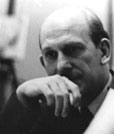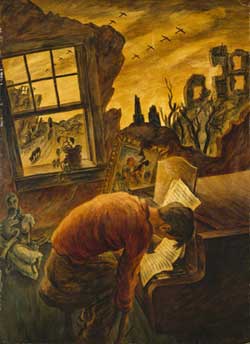The scene reminded me of Thomas Hart Benton. An old pickup truck sat parked near a railroad crossing as the driver engaged in a conversation with a man idling at his door. Coming towards them was a boy on a bike just about to cross railroad tracks that likely split their small town.
The entire scene told a story of a country town that could have been in the South or the Midwest, and there were enough images in it to paint a picture of a life that was poor, laid back, family-focused, insular and contented. The artist had cleverly printed the year in the license plate on the truck: 1942.
It was titled “Country Crossing,” pencil-signed by Carlos Andreson, with a label on the back.

The lithograph on paper was among the items being sold recently in a Modern Design sale at auction. This was one of those sales where the prices are high and the furniture is elegant. I’ve come across some of the most interesting and unusual pieces at these auctions, and I’ve picked up some very good artists at great prices.
I was hoping that this print would be one of them. I was struck by its similarity to Benton’s style and his way of dignifying the lowly people he drew. Benton created Depression-era poor folks who lived hard lives off their land, but had spirit, spunk and heart. Life was tough for them, but they didn’t allow it to break them.
 he artist Carlos Andreson seemed to capture the same endurance of spirit in this piece. I was not familiar with his name, so I Googled him.
he artist Carlos Andreson seemed to capture the same endurance of spirit in this piece. I was not familiar with his name, so I Googled him.
Andreson was a painter, lithographer, printer and teacher who was born in Midvale, UT, in 1905 (or 1904, depending on who you read). He studied art both here and abroad, exhibiting his works in Stockholm and Paris while living and studying in Europe, according to the Naval Historical Center website. The photo of Andreson at right is from the Utah State Historical Society website.
In the 1930s, he participated in the Works Progress Administration’s (WPA) Federal Arts Project. He was commissioned to paint sketches of early life in Utah that consisted primarily of historical buildings, according to the Springville (Utah) Museum of Art, which mounted a retrospective of his works in 2009. The works are now part of the state’s WPA Collection. Andreson also taught at the Utah Arts Center as part of the WPA.
According to one biography, his specialty as an artist was lithography.

During the 1940s, he was one of the artists commissioned by Abbott Laboratories to do paintings of naval hospitals in this country and abroad. They were known as “art correspondents,” and with the cooperation of the military, they lived among the medical personnel. The Navy Art Collection has 17 of his works. He is also in the collections of several major museums, including the Metropolitan Museum of Art and the American Art Museum at the Smithsonian.
Andreson worked in New York, Salt Lake City and San Francisco. In the 1950s, he painted a plywood mural of the Port of Oakland, CA.
He was born Carlos J. Anderson, but reversed the “r” and “e” in his last name to make it different from other artists with the same last name, according to one account. He died in Salt Lake City in 1978.

Another copy of the lithograph like the one at the auction sold during a 2010 exhibition at an art gallery in Raleigh, NC. There was no price mentioned on the gallery website. I found two others of his lithographs selling for $500 and $975.
I decided to bid for “Country Crossing.” As usual, the auctioneer ventured high but soon dropped low as there were no takers. I took the low bid and went tit-for-tat with another bidder until the person finally backed off. I got the lithograph for $30.
Glad to meet you, Carlos Andreson.
